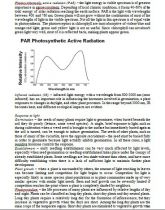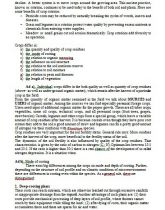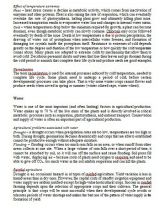Přednášky: Environmental Factors Affecting Crop Production
Skrýt detaily | Oblíbený- Kvalita:84,2 %
- Typ:Přednášky
- Univerzita:Česká zemědělská univerzita v Praze
- Fakulta:Fakulta životního prostředí
- Kategorie:Přírodní vědy
- Podkategorie:Ekologie a environmentalistika
- Předmět:Životní prostředí
- Autor:eliseus
- Rozsah A4:21 strán
- Zobrazeno:1 548 x
- Stažené:0 x
- Velikost:1,5 MB
- Formát a přípona:MS Office Word (.doc)
- Jazyk:anglický
- ID projektu:3654
- Poslední úprava:16.06.2014
All crops differ in their biological characteristics and their environmental requirements, while the physical character of the earth’s surface varies greatly from place to place. A great many variables influence plant growth, including day-length, the amount of solar energy received, the amount of precipitation available for transpiration, temperature during growing season and others. Many of these variables, all critical for successful plant growth, can be modified by farmer. But all these modifications of the natural environment are costly. There are, however, some parts of the earth’s surface where a particular crop will grow best without these modifications, and a knowledge of such places helps to explain the distribution of crops.
Light
Solar radiation
Solar radiation is radiant energy (particularly electromagnetic energy) emitted from the surface of the sun, which is powered by nuclear fusion. The electromagnetic radiation emitted by the sun shows a wide range of wavelengths. Fortunately, the highly injurious ionizing radiation does not penetrate the earth's atmosphere. About half of the radiation which reaches the earth surface is in the visible short-wave part of the electromagnetic spectrum. The other half is mostly in the near-infrared part, with some in the ultraviolet part of the spectrum.
Light
Solar radiation
Solar radiation is radiant energy (particularly electromagnetic energy) emitted from the surface of the sun, which is powered by nuclear fusion. The electromagnetic radiation emitted by the sun shows a wide range of wavelengths. Fortunately, the highly injurious ionizing radiation does not penetrate the earth's atmosphere. About half of the radiation which reaches the earth surface is in the visible short-wave part of the electromagnetic spectrum. The other half is mostly in the near-infrared part, with some in the ultraviolet part of the spectrum.




